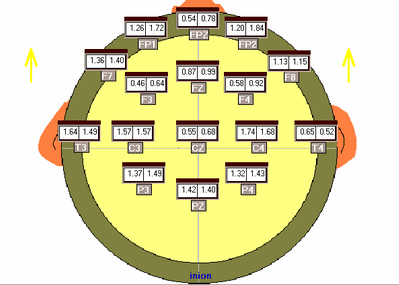| Brain Waves | 2002-05-31 19:40 28 comments |
 by Flemming Funch by Flemming FunchA friend of mine, Ron Fitch, who's trained in such things, did a brain mapping test on me today. That is where you test, with EEG equipment connected to a computer, the ratios of different types of brainwaves in different parts of the brain. The functioning of the brain is something that currently interests me, so I thought that would be fun and educational. Which it was. This particular way of testing is to measure the degree of awakeness/activity versus asleepness in different strategic places. Beta waves divided by theta waves. In principle if you're alert and present and able to deal with what is going on around you, you're primarily in the beta state. You're alert and/or working. If you're in a drowsy or dreamy state, you're primarily in the theta state. Beta waves are fast, theta waves are slow. In between beta and theta are alpha waves, where you're relaxed and meditative. And then there are delta waves, which are slower than theta. They'd be associated with deep dreamless sleep. The tests are being done first in a relaxed state where one is just sitting there. That's the numbers on the left. And then in a stressed state, where one is figuring out something complicated or reliving some emotional trauma. That's the number on the right. These kind of tests are useful, for one thing, to diagnose somebody with ADD (Attention Deficit Disorder), as it has apparently been found that some people with that kind of ADD will go more asleep when confronted with tasks to do, rather than becoming more alert, which is why they need distractions, to keep themselves awake. On the picture it is the head seen from above, with the nose pointed to the top. Briefly, the way I understood the results ... The bottom 3 sets of numbers, P3, P4 and PZ relate to the processing of perceptions, and they apparently show that I have excellent perceptual acuity. I.e. noticing what is going on around me. I think the norm or baseline is 1.25. The top (front) 3 sets of numbers, FP1, FPZ and FP2, are about experiencing emotions and other conscious thinking, I believe. F3, FZ and F4 are about the deeper processing of them. C4 shows a good ability to visualize things spatially, but T4 shows a weakness in practically working with that, such as in working out the design of something on a piece of paper. C3 and T3 shows good logical ability, inside and out. Otherwise, what I'm told that it shows is that the two sides (left brain: logical, specific; right brain: intuitive, wholistic) are well balanced. I.e. they're fairly equally active. But the weaker points are in the integration between the two, which are the numbers in the middle. I.e. I might be good at being logical and precise, and I might be good at being intuitive and sense the whole, but I don't necessarily succeed in doing both at the same time, or in traslating well from one to the other. Oh, none of this is an overly exact science, as scientists still don't really know how the brain works, and certainly can't say much about what it has to do with ME, but I still think it is useful and interesting. |